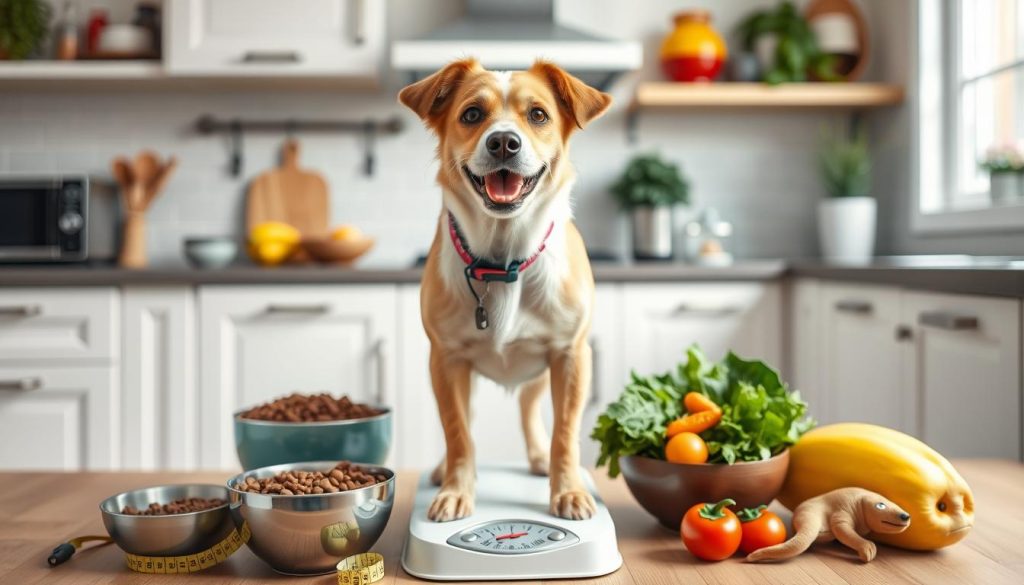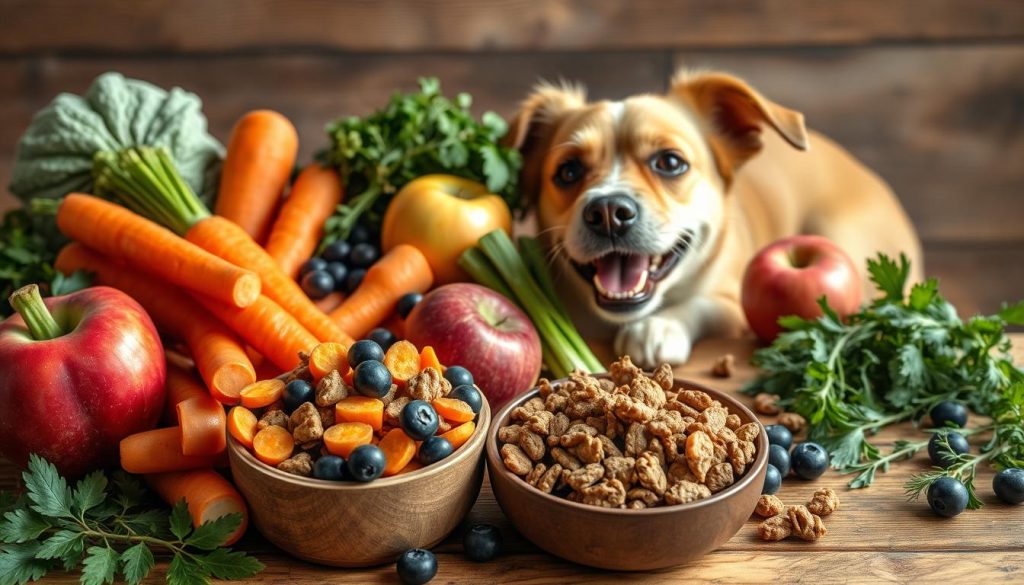As a devoted dog owner, I know how crucial it is to give your furry friend the best nutrition. In this article, I’ll share key dog food tips to keep your pup happy and healthy. These tips will help you make informed choices about your dog’s diet.
Whether you’re new to dog ownership or want to improve your feeding routine, this guide is for you. We’ll explore the importance of quality protein, carbs, and fats. You’ll learn how to pick the right dog food for your pup’s life stage. By the end, you’ll understand your dog’s nutritional needs better.
So, let’s dive in and find out the essential dog food tips for your pup’s well-being. Get ready to learn how to give your dog the best diet, tailored to their unique needs and preferences.
The Importance of Quality Ingredients in Dog Food
Keeping your dog happy and healthy starts with their diet. High-quality dog food is key. It gives them the nutrients they need to thrive.
Identifying High-Quality Protein Sources
Protein is vital for your dog’s muscles and growth. Choose dog food with real meat or fish like chicken, beef, or salmon. Avoid foods with lots of plant-based proteins or byproducts.
Understanding the Role of Carbohydrates and Fats
Your dog also needs carbs and fats. Carbs give energy, and fats keep their skin, coat, and organs healthy. Look for dog food with whole-grain carbs and healthy fats like fish oil or flaxseed.
| Nutrient | Importance for Dogs | Examples of High-Quality Sources |
|---|---|---|
| Protein | Muscle growth and development | Chicken, beef, salmon |
| Carbohydrates | Energy source | Brown rice, oats |
| Fats | Healthy skin, coat, and organ function | Fish oil, flaxseed |
Choosing the right dog food is crucial. It should have the right mix of protein, carbs, and fats. A balanced diet is the key to a happy, healthy dog.
Choosing the Right Dog Food for Your Pup’s Life Stage

As a responsible pet owner, it’s key to know your dog’s nutritional needs change with age. Whether your furry friend is a growing puppy, an active adult, or a senior dog, picking the right dog food for different life stages is vital for their health and happiness.
Puppies need special food to support their fast growth and development. Puppy food has more calories, protein, and vitamins and minerals. This ensures your young pup gets the nourishment they need. Adult dog food, on the other hand, helps keep an adult dog’s muscle mass, energy, and health in check.
When your dog gets older, their metabolism slows down, and they may need senior dog food. This food is lower in calories but rich in nutrients like glucosamine and chondroitin. These help support their joint health. Choosing the right dog food for your pup’s life stage helps them thrive and live a long, healthy life by your side.
Remember, the key to your dog’s optimal health is to think about their age, activity level, and individual needs when picking their food. By making informed choices, you can give your beloved companion the high-quality, tailored nutrition they deserve at every stage of their life.
Dog Food Tips for Maintaining a Healthy Weight

Keeping your dog at a healthy weight is vital for their happiness and health. It’s important to control portions and follow feeding guidelines. This ensures your dog gets the right amount of food without gaining too much weight. Here are some tips to help your dog stay fit and healthy.
Portion Control and Feeding Guidelines
Controlling portions is crucial for a healthy dog weight. The right amount of food depends on your dog’s age, how active they are, and their breed. Always follow the feeding guidelines on your dog food’s packaging. Adjust these amounts based on your dog’s unique needs.
To avoid overfeeding your dog, try these tips:
- Use a measuring cup or scale to measure your dog’s food accurately.
- Divide your dog’s daily food into smaller meals instead of leaving it out all day.
- Change the portion sizes based on your dog’s body condition and energy level.
- Limit treats and table scraps, as they can add a lot of calories and cause weight gain.
It’s also key to have a regular feeding schedule. Most dogs prefer two or three meals a day. This helps keep their appetite in check and helps them stay at a healthy weight. Make sure to always provide fresh, clean water for your dog to stay hydrated.
| Dog Weight | Recommended Daily Food Intake (Cups) |
|---|---|
| 10 lbs | 1 – 1.5 |
| 20 lbs | 1.5 – 2.5 |
| 30 lbs | 2 – 3 |
| 40 lbs | 2.5 – 3.5 |
| 50 lbs | 3 – 4 |
These are just general guidelines. Your dog’s needs might be different. Always talk to your vet to find the best feeding plan for your dog’s health.
Addressing Dietary Sensitivities and Allergies
We all want the best for our pets. That means giving them the right food for their health. But, some dogs might have food allergies or sensitivities. These can lead to health problems.
It’s key to know about these issues. This way, we can make sure our pets get the food they need.
Recognizing Signs of Food Intolerances
Spotting food intolerance signs in your dog is the first step. Look out for:
- Persistent skin irritation or inflammation
- Gastrointestinal issues, such as vomiting, diarrhea, or excessive gas
- Recurring ear infections or ear inflammation
- Unexplained weight loss or poor growth in puppies
If your dog shows these signs, see your vet. They can help find the cause and suggest a plan. This might include special dog food or diet changes.
Being proactive about your dog’s diet can make a big difference. It might take some time to find the right food. But, it’s worth it for your pet’s health.
The Benefits of Fresh, Whole Foods in Your Pup’s Diet

We all want the best for our pets. High-quality dog food is convenient, but fresh, whole foods offer more. They make mealtime natural, nourishing, and tasty for your dog.
Whole foods like meats, veggies, fruits, and grains are full of nutrients. They boost your dog’s immune system and keep their skin and coat healthy. These foods are easy for dogs to digest, giving them the most nutritional value.
Also, a whole food diet lets you tailor your dog’s meals. You can choose ingredients based on their needs and likes. This makes mealtime more enjoyable for your dog.
Adding fresh, whole foods to your dog’s diet is easy. Start by mixing in small amounts of cooked, plain proteins, veggies, and carbs. Always check with your vet to make sure you’re giving the right balance of nutrients.
Choosing a whole food diet is a great way to care for your dog. It boosts their energy and overall health. Feed them fresh, natural ingredients and see the difference in their happiness and health.
Whole Food Dog Diet: A Natural Approach to Canine Nutrition
- Abundant in essential nutrients: vitamins, minerals, and antioxidants
- Easily digestible and well-absorbed by your dog’s body
- Customizable to address individual dietary needs and preferences
- Promotes overall health, energy, and well-being
| Whole Food Ingredient | Nutritional Benefits |
|---|---|
| Lean Protein (e.g., chicken, turkey, or fish) | Supports muscle development and maintenance |
| Fresh Vegetables (e.g., carrots, spinach, sweet potatoes) | Rich in fiber, vitamins, and antioxidants |
| Whole Grains (e.g., brown rice, quinoa, oats) | Provide complex carbohydrates and essential nutrients |
| Healthy Fats (e.g., omega-3s from fish oil) | Promote skin and coat health, as well as brain function |
Dog Food Tips: Decoding Dog Food Labels
Understanding dog food labels can seem hard, but it’s key for your dog’s health. I’ll show you how to read labels, from ingredient lists to nutritional info.
Understanding Ingredient Lists and Nutritional Information
First, learn about the ingredient list on dog food labels. Look for real meat, poultry, or fish as the main dog food ingredients. Stay away from vague terms like “meat by-products” or “animal fat.”
Then, check the nutritional info panel. It shows the percentages of dog food ingredients like protein, fat, and carbs. Choose a dog food that fits your dog’s life stage and activity level.
| Nutrient | Recommended Percentage for Adult Dogs | Recommended Percentage for Puppies |
|---|---|---|
| Protein | 18-30% | 22-34% |
| Fat | 10-15% | 12-18% |
| Carbohydrates | 30-50% | 20-40% |
By learning to read dog food labels and understand the nutritional info, you can pick the best food for your dog.
Creating a Balanced and Nutritious Meal Plan
It’s crucial to make sure your dog eats well to stay healthy and happy. Knowing what a balanced diet for dogs includes helps you feed them right. This way, you can keep your furry friend in top shape.
A good dog diet has protein, carbs, and fats. Think about your dog’s age, how active they are, and any special needs they might have. This helps you make a meal plan that’s just right for them.
- Choose High-Quality Protein: Look for dog foods with real meat like chicken, beef, or fish. These are key for your dog’s muscles and health.
- Add Healthy Carbohydrates: Whole grains, veggies, and fruits give your dog fiber, vitamins, and minerals. Choose complex carbs over simple sugars.
- Include Beneficial Fats: Fats from fish oils or plant-based oils keep your dog’s skin and coat healthy.
- Adjust Portions: Feed your dog the right amount based on their size, age, and activity level. This keeps them at a healthy weight.
- Try Homemade Recipes: If you can, make your own dog food. Use fresh, whole ingredients for a balanced diet.
| Nutrient | Importance | Good Sources |
|---|---|---|
| Protein | Supports muscle growth and maintenance | Lean meats, poultry, fish, eggs |
| Carbohydrates | Provide energy and fiber | Whole grains, vegetables, fruits |
| Fats | Support skin, coat, and overall health | Fish oils, plant-based oils |
By planning a balanced diet for your dog, you ensure they get all the nutrients they need. Whether you pick a top-notch commercial food or make your own, these tips help. They help you give your dog a diet that supports their health and happiness.
Transitioning to New Dog Food: A Gradual Approach
Switching your dog to a new food needs to be done slowly. Changing their diet too fast can upset their stomach. I’ll guide you on how to introduce new food to your dog’s diet smoothly.
Start by mixing a little of the new food with their old food. Gradually add more new food over a week or two. This slow change helps their stomach adjust without upset.
Watch your dog closely during this time. If they seem uncomfortable or eat less, slow down the change. Every dog is different, so adjust the transition to fit their needs.

